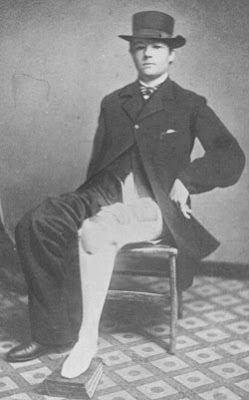Brought to Life has images of 4,000 medical objects selected from the
Science Museum's collections. From amulets to alligators, leech jars to
lodestones you can find all of these from here. The Museum's objects,
many of which are from the Wellcome Trust, cover more than 3,000 years
of medical history.
 |
| another item from the Smithsonian. Made in the same style as a glove of
the period, although the fingers are clearly articulated there is no
locking mechanism and hence no real gripping mechanism. It is for this
reason that hooks were used making ergonomics a priority over anatomical
accuracy. - LINK |
 |
| The first lightweight alloy prosthetic leg, was designed for WWI aviator
Desouttter, by his brother. The use of aluminum alloys cut the weight
of the leg in half, from his previous wooden one, allowing him to fly
again. - LINK |
 |
| Wooden leg of Mexican general at the Alamo - LINK |
 |
| The large number of amputations in the Civil War created the demand for
what became known as the American leg, a variant of the Anglesea leg
created in England, which had artificial tendons which lifted the toes
when the leg was bent.- LINK |
 |
| A prosthetic metal arm from around the time of Gotz von Berlichingen - LINK |
 |
| Multi-attachment Swiss Army Prosthetic hand - LINK |
 |
| The Science Museum's new
online exhibition - LINK |
 |
| Ancient Egyptian prosthetic toe - LINK |
 |
| Part of the Smithsonian collection, an ingenious grabber. - LINK |
 |
| "The Roman Capua Leg is an artificial leg, found in a grave in Capua,
Italy. Dating from 300 BC, the leg is one of the earliest known
prosthetic limbs. The limb was kept at the Royal College of Surgeons in
London, but was destroyed in World War II during an air raid."- LINK |
 |
| Made from steel and brass, this unusual prosthetic arm articulates in a
number of ways. The elbow joint can be moved by releasing a spring,
whereas the top joint of the wrist allows a degree of rotation and an
up-and-down motion. The fingers can also curl up and straighten out.
The leather upper arm piece is used to fix the prosthesis to the
remaining upper arm. The rather sinister appearance of the hand suggests
the wearer may have disguised it with a glove - LINK |
 |
| Among other items are pedoscopes - which measured feet using X-rays - and
"Jedi helmets" for scanning children's brains - LINK |
 |
| Known as the clapper because of the sound its articulated toes with
artificial tendons made, this is a later version of the Anglesea leg,
which was widely used by Napoleonic War veterans, and designed by James
Potts in 1800. It became the model for the first mass produced
artificial limbs, including the American leg. - LINK |
 |
| The wooden hand is designed to allow the wearer to span an octave on the piano - LINK |
 |
| Aside from its famous owner, this leg is interesting because it is a
transitional type, somewhere in between a fixed pirate style stump and
the artificial tendon articulation of the Anglesea leg. - LINK |
 |
| Antique wooden leg with concealed gun - LINK |
 |
| Napoleon's toothbrush, 19th century tattoos, glass eyes, prosthetic limbs,
early antibiotics and wartime first aid field equipment are just some of the
objects that help tell the stories of healthcare and illness over the
centuries - LINK |




















No comments:
Post a Comment